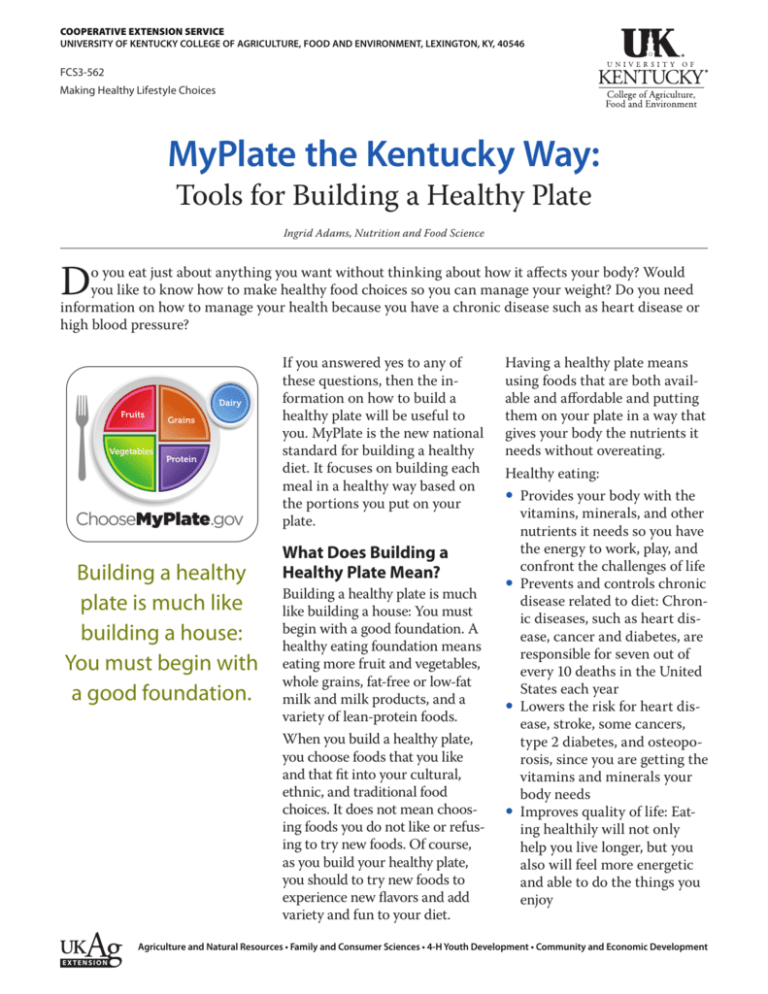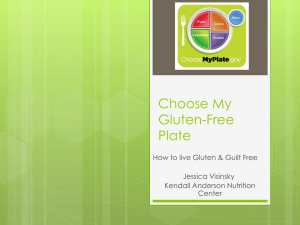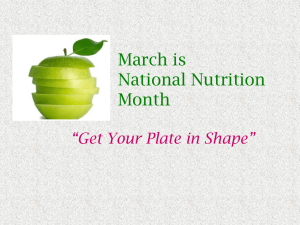MyPlate the Kentucky Way - UK College of Agriculture
advertisement

COOPERATIVE EXTENSION SERVICE UNIVERSITY OF KENTUCKY COLLEGE OF AGRICULTURE, FOOD AND ENVIRONMENT, LEXINGTON, KY, 40546 FCS3-562 Making Healthy Lifestyle Choices MyPlate the Kentucky Way: Tools for Building a Healthy Plate Ingrid Adams, Nutrition and Food Science D o you eat just about anything you want without thinking about how it affects your body? Would you like to know how to make healthy food choices so you can manage your weight? Do you need information on how to manage your health because you have a chronic disease such as heart disease or high blood pressure? If you answered yes to any of these questions, then the information on how to build a healthy plate will be useful to you. MyPlate is the new national standard for building a healthy diet. It focuses on building each meal in a healthy way based on the portions you put on your plate. Building a healthy plate is much like building a house: You must begin with a good foundation. What Does Building a Healthy Plate Mean? Building a healthy plate is much like building a house: You must begin with a good foundation. A healthy eating foundation means eating more fruit and vegetables, whole grains, fat-free or low-fat milk and milk products, and a variety of lean-protein foods. When you build a healthy plate, you choose foods that you like and that fit into your cultural, ethnic, and traditional food choices. It does not mean choosing foods you do not like or refusing to try new foods. Of course, as you build your healthy plate, you should to try new foods to experience new flavors and add variety and fun to your diet. Having a healthy plate means using foods that are both available and affordable and putting them on your plate in a way that gives your body the nutrients it needs without overeating. Healthy eating: yy Provides your body with the vitamins, minerals, and other nutrients it needs so you have the energy to work, play, and confront the challenges of life yy Prevents and controls chronic disease related to diet: Chronic diseases, such as heart disease, cancer and diabetes, are responsible for seven out of every 10 deaths in the United States each year yy Lowers the risk for heart disease, stroke, some cancers, type 2 diabetes, and osteoporosis, since you are getting the vitamins and minerals your body needs yy Improves quality of life: Eating healthily will not only help you live longer, but you also will feel more energetic and able to do the things you enjoy Agriculture and Natural Resources • Family and Consumer Sciences • 4-H Youth Development • Community and Economic Development EXTENSION Steps to Building a Healthy Plate Step 1: Fill Half your Plate with Vegetables and Fruit You may use any type of fruits or vegetables to fill this half. Fresh crisp vegetables such as carrots and broccoli are easy to prepare and can be made more appealing by adding a low-fat dressing. Placing whole fresh fruit on the side of the plate can also be a great way to add a serving of fruit to the mix. Vegetables Vegetables provide potassium, dietary fiber, folate, vitamin A, and vitamin C as well as other plant chemicals. The vitamins, minerals, and other substances in vegetables keep the body healthy and prevent diseases. Eating a diet rich in vegetables may reduce a person’s risk for heart disease, type 2 diabetes, and certain types of cancers. Vegetables such as spinach, winter squash, and greens are rich in potassium and may help lower blood pressure, reduce the risk of developing kidney stones, and help prevent bone loss. In addition, vegetables are low in calories and are high in fiber. They help a person feel full without the calories and, as a result, help manage weight. Filling half your plate with vegetables means making sure you purchase, prepare, and serve them at every meal. You may want to begin by buying vegetables when they are in season, when they are fresh and cost less. Plan your meals around a certain vegetable and add other food to go along with it. Tips yy Have vegetables in the home at all times. yy Remember: The darker the lettuce, the more nutrients it contains. yy Serve vegetables at every meal. yy Add vegetables to soups, stews, casseroles, pizza, rice, and pasta dishes. yy Keep a bowl of cut-up vegetables in the refrigerator, and use as a snack during the day. yy Make vegetables more appetizing by adding a low-fat dip or dressing. Fruits Fruits, like vegetables, provide vitamin C, dietary fiber, folate and potassium that help control blood pressure. Fruits rich in potassium include bananas, prunes, dried peaches, cantaloupe, honeydew melon, and oranges. Fruits contain soluble fiber that help reduce blood cholesterol levels and may lower the risk of heart disease. Research shows that people who eat a diet high in fruits (about five servings per day) were less likely to have chronic diseases such as cardiovascular disease and certain cancers. 2 It is important to purchase fruits and have them in the home so they are easily accessible. Note that some people may not like to place fruit on their plate, where it might come in contact with meat and other savory foods. If this is the case, you should fill half your plate with vegetables and serve the fruit in a bowl. Tips yy Keep a bowl of whole fruit on the table, counter, or in the refrigerator. yy Add berries, bananas, or peaches to your cereal. yy Add fruit to tossed salad. yy Use fruits such as apples, bananas, or strawberries as snacks. yy Use fruit topped with low-fat yogurt or some cinnamon for dessert. Baked apples are an excellent example. Step 2: Fill a Quarter of your Plate with Grains In one quarter of the plate, add a whole grain; this grain can be anything from whole-grain toast to whole-grain pasta in a casserole. Grits are also an excellent source of fiber. Any food made from wheat, rice, oats, cornmeal, or barley is a grain product. Bread, pasta, rice, tortillas, and grits are examples. Cereals such as oatmeal and breakfast cereals are also included in this group. Grains are divided into two groups: 1. Whole grains contain the bran, germ, and endosperm of the grain. Examples include whole-wheat flour, oatmeal, bulgur, whole cornmeal, and brown rice. 2. Refined grains have the bran and germ removed during milling. The grain has a finer texture but contains fewer nutrients because dietary fiber, B vitamins and iron are removed. Except for the fiber, most nutrients are added back to the refined grain. When you fill your plate with grains, try to include whole grain instead of refined grain. Research shows eating three or more servings of whole grain a day may lower the risk of cancer by 20 percent. Whole grains help reduce cholesterol and may lower your risk for heart disease, obesity, and type 2 diabetes. It also helps the bowel to function properly by reducing constipation and a disease called diverticulosis—small pouches that form in the wall of the colon. Step 3: Fill a Quarter of your Plate with Lean Protein Now that we know what fruits, vegetables, and grains we have on our plate, we need to decide what protein will go well with them and really pull the meal together. Protein does not always have to be a meat. Here are some things you should know: yy Protein foods include meat, poultry, seafood, eggs, processed soy products, nuts, and seeds. yy Dried beans and peas also are a part of this group and should be included in meals or used to replace protein foods. yy One serving of protein is 4 ounces of steak; 1 small lean hamburger, 2 to 3 ounces; 3 ounces of chicken breast; a can of tuna, drained; 4 ounce salmon steak; 1 cup split pea, lentil, or bean soup; or a soybean burger patty. yy Include at least 8 ounces of cooked seafood per week for adults. If you are unfamiliar with cooking seafood, ask around for a good casserole or tuna salad recipe. 3 Tips yy Select a variety of protein foods to improve nutrient intake and health benefits. Getting both plant and animal proteins can help to ensure that your body gets the proteins it needs throughout the day. yy Limit the intake of processed meats such as hot dogs, sausages, pepperoni, and luncheon meats. yy Try to plan meals around the vegetables rather than the protein. If you want to have sweet potatoes or a tossed salad for dinner, think of a protein that will go well with them. Step 4: Include Some Foods from the Dairy Group Try to include a dairy product such as cheese, yogurt, or milk on the side or as part of a dish on your plate. Dairy products provide calcium, potassium, vitamin D, and protein that improve bone health and may reduce the risk of osteoporosis. Dairy products may also reduce the risk of cardiovascular disease, type 2 diabetes, and blood pressure. Having three servings of milk per day helps to improve bone health. Choose fat-free or lowfat products low in saturated fats and cholesterol. Products high in saturated fats and cholesterol can increase risk for heart disease. Older children, teens, and adults need 3 cups of dairy a day, while children 4 to 8 years old need 2½ cups, and children 2 to 3 years old need 2 cups. All fluid milk products and many foods made from milk are considered part of this food group. Most dairy choices should be fat-free or low-fat. Foods made from milk that retain their calcium content are part of the group. Foods made from milk that have little to no calcium, such as cream cheese, cream, and butter, are not considered part of the dairy group. Calcium-fortified soymilk (soy beverage) is also part of the dairy group. Tips yy Include fat-free or low-fat milk, or calcium-fortified soy milk with meals. yy Have fat-free or low-fat yogurt or cheeses as a snack. yy Add fat-free or low-fat dairy to breakfast cereals and desserts. yy Add yogurt to fruit smoothies. yy Top a baked potato with fatfree or low-fat plain yogurt. yy If you do not drink milk, use soy, almond, or other vegetable forms of milk. yy Add low-fat cheeses to casseroles. yy Use skim milk instead of water in recipes for certain baked goods. Can desserts and sweets be part of a healthy plate? Filling half your plate with fruit and vegetables, and the other half of the plate with lean protein and some grains or starchy food allows you to fill your plate the healthy way. Building a healthy plate allows room for some dessert or a sweet treat on the side. If you make healthy food choices and you are meeting your nutritional needs it is okay to enjoy some desserts every once in a while. Eating Breakfast It is common to skip breakfast due to time constraints or just not being hungry in the morning. Remember: Breakfast is one of the most important meals of the day, because it is what tells your body it is time to get up and start your day. Studies show that eating breakfast can reduce hunger throughout the morning and prevent over eating at lunchtime. It also provides the energy to stay focused in the morning. You may have some difficulty getting all of the food groups in at breakfast, but here are some healthy ways to include more: yy Add granola and fruit to a yogurt. This simple breakfast includes dairy, grains, and fruit. yy Have a bowl of unsweetened cereal with milk and add fruit. yy Another great to-go option is to make an egg sandwich by poaching or scrambling eggs, putting them on whole grain toast and adding tomato. If you are still hungry, you can grab a banana to go. 4 yy Another way to make sure you have breakfast is to prepare what you can the night before so that you can wake up, grab your breakfast and be out the door. A fruit smoothie made with yogurt—ready to take along with you in case you do not have time to sit down and eat—is a great option. Stay active Getting all of the nutrients you need isn’t the only thing necessary for good health. Guidelines for good health recommend being physically active for at least 30 minutes most days of the week. This activity can include anything from walking at work to working in a garden or going for a swim. Physical activity does not always mean going to the gym or running a mile. It can also be enjoying some playtime with your kids, cleaning house, or going for a walk with some friends. Some tips for staying physically active include: yy Find something you enjoy. If you like to garden, plant some vegetables or herbs. yy Plan the time. You may have a busy schedule, but if you set aside the time to be physically active, you are much less likely to skip it. yy Have partners, if you like to walk. Turn your walk into time with family or friends. Being committed to this time with someone else will give you more incentive to get out and do it. yy Find people to support you. If you know people are rooting for you to work physical activity into your schedule, it will give you encouragement along the way. yy Set manageable goals. Identifying goals to celebrate along the way will make exercise more fun and rewarding. yy Remember: If you eat 100 more food calories a day than you burn, you’ll gain about 1 pound in a month. Resources Centers for Disease Control and Prevention, Analyze My Plate: http://www.fruitsandveggiesmatter.gov/activities/analyze_ my_plate.html. Centers of Disease Control and Prevention, Fruits and Vegetables: http://www.fruitsandveggiesmatter.gov/. United States Department of Agriculture Food Plans: http://www.choosemyplate. gov/myplate/index.aspx. Whole Grain Council: http:// www.wholegrainscouncil. org/whole-grains-101/healthstudies-on-whole-grains. Project assistant, Mallory Foster, Dietetics and Human Nutrition graduate student. Educational programs of Kentucky Cooperative Extension serve all people regardless of race, color, age, sex, religion, disability, or national origin. Issued in furtherance of Cooperative Extension work, Acts of May 8 and June 30, 1914, in cooperation with the U.S. Department of Agriculture, M. Scott Smith, Director, Land Grant Programs, University of Kentucky College of Agriculture, Lexington, and Kentucky State University, Frankfort. Copyright © 2012 for materials developed by University of Kentucky Cooperative Extension. This publication may be reproduced in portions or its entirety for educational or nonprofit purposes only. Permitted users shall give credit to the author(s) and include this copyright notice. Publications are also available on the World Wide Web at www.ca.uky.edu. Issued 9-2012





